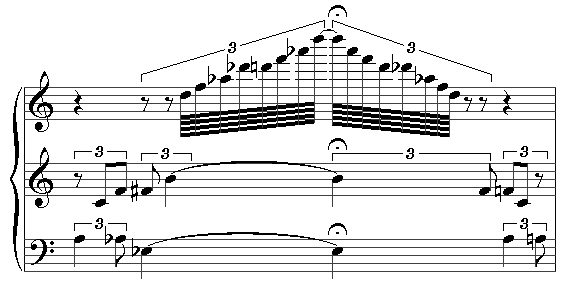Palindromes
pal·in·drome
ˈpalənˌdrōm/
noun
- a word, phrase, or sequence that reads the same backward as forward, e.g., madam or nurses run.
Sounds fun right? I actually Wikipedia-ed it because I was curious about the word origin and who actually thought up the concept of palindromes, but I actually found out some things that were far more interesting. Palindromes are like how the word racecar, spelled backward, is still racecar. Or how taco cat spelled backward is still, in fact, taco cat. It works with phrases too! For example, there is no "x" in Nixon, is still there is no "x" in Nixon backward. Cool right? Just wait, it gets BETTER.
Palindromes can be found outside words, phrases, or writing altogether. One such example is a piece of an opera (shown below) written by Alban Burg called Lulu.
The sequence of notes goes: D F♭ A♭ D♮ D F♭ A D | D A F♭ D D♮ A♭ F♭ D
As you can see on the top treble staff, there is a series of notes that go up and down, mirroring itself exactly forward and backward, creating the palindrome. While you technically "write" music, it's interesting to see the same concept across multiple mediums. The next picture describes palindromes that can be found in biology.
This example has to do specifically with DNA nucleotides: Guanine (G), Thymine (T), Adenine (A), and Cytosine (C). C always pairs with G, and A always pairs with T. So, in the left part of the picture, the top strand's sequence reads G A T C, and the bottom strand reads C T A G, creating the palindrome. Neat right?
While the word Palindrome was originally coined to describe when words or phrases could be read the forwards and backward, the word eventually came to describe the phenomenon of something being able to be read forwards and backward. It's interesting how the word has come to have a broader definition to not only describe words that this phenomenon but even when this phenomenon is found in music and our own DNA. Think, not only can you read a palindrome on paper, but you potentially have one inside your own body.
~Maryちゃん


This comment has been removed by the author.
ReplyDeleteRats live on no evil star. That is one of my favorite English palindrome. Your post inspired me to look up palindromes in Japanese. The Japanese word for palindromes is 回文 (kaibun). I found one that was quite interesting to me: 長き世の 遠の眠りの 皆目覚め 波乗り船の 音の良きかな (Na-ga-ki yo-no to-ho-no ne-bu-ri-no mi-na me-za-me na-mi-no-ri-bu-ne-no o-to-no-yo-ki-ka-na). Which is from a poem and translates to "Everybody gets awakened from a long sleep and enjoys the sound of waves on which the boat is gliding along."
ReplyDeleteThank you! I didn't even think to look them up in Japanese!
DeleteAnd 「回文」, I'll try to remember that!
ありがとう~
Wow! I had no idea the word palindrome could be used to describe non-word related phenomena. Don't get me wrong, words that are palindromes are fun in and of themselves, but I liked the examples you provided in music and biology. This sparked my thinking and makes me wonder where else might I encounter a palindrome.
ReplyDeleteFun post to consider those other aspects of language that can keep up intrigued beyond the textbook "stuff" you mention at the start of this post. I also appreciated the consideration of palindromes existing in other areas outside of language.
ReplyDeleteThis was such a fun read. I have has little experience with palindromes and really only thought they existed in the world of language. As someone who loves biology, I was really glad you mentioned the makeup of a genetic palindrome. The nucleotide in specific patterns are interesting to consider in terms of how the DNA is read, but it is also interesting considering the pattern of having it "mirrored" as a palindrome would as well. Aesthetically speaking you could be able to find faux palindromes on a physical level as well. Thanks for doing the research and sharing!
ReplyDeleteNot quite the opposite of a palindrome is an emordnilap which is a word that can be read as a different word in reverse. The word palindrome itself is an example of one. My personal favorite palindrome is the word 'Racecar".
ReplyDeleteYes! I've heard of those. I thought about talking about them in this post but I was afraid that it would make the post super lengthy haha
Delete